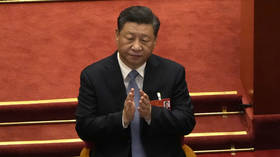What China’s new foreign relations law means

China has recently passed a new “foreign relations law.” The law, which references “an opposition to hegemony and power politics” is a codification of Beijing’s foreign policy goals and its mechanisms of reacting to Western-imposed sanctions and attempts to contain it. But what exactly does this law mean? And what are the consequences for the US-China standoff?
The centralization of China’s foreign policy
As the geopolitical climate has shifted, China’s foreign policy-making has been significantly centralized in response to growing insecurity and uncertainty triggered by efforts to contain it by the United States, which has attempted to challenge the onus of the country’s development and foreign relations. Under Xi Jinping, this has led to a reassertion of the role of the Party as the political core of the state, bringing an end to years of decentralization in which the West hoped for an ideological transformation.
In parallel to this move, China has sought to increasingly entrench its legal system in order to facilitate “rule of law” more strongly into society. It continues to see this issue as a vital part of the country’s process, as opposed to it being about raw power politics. In this case, Beijing believes that its foreign policy is best served by a codified unification of all state and legal organs to meet the challenge of the US, which can be undermined by factors such as disunity, corruption, or clashes of interests. Of course, this runs parallel to how the state has purposefully enacted regulatory crackdowns on certain business sectors and individuals. The Party has reasserted its ideological role over the country.
Multipolarity
In understanding what this law aims to achieve, one of its key components is that it legally enshrines China’s own commitment to building a multipolar international order, drawing a contrast to US led unipolarity. Beijing describes the multipolar world it envisions as “democratic,” meaning that states stand equally and work together, as opposed to a group of states (such as the West) having excessive power over others.
The law describes China’s vision for multipolarity as “global development initiatives, global security initiatives, and global civilization initiatives, and promotes an all-round, multi-level, wide-ranging, and three-dimensional external work layout.” Calling for “reform of the global governance” system, it expresses intention to “maintain and practice multilateralism” through mechanisms such as the United Nations, but also those which China has proposed including the Belt and Road initiative (BRI).
The initiative emphasizes many other key points China has long called for, including respect for national sovereignty and non-interference in internal affairs. Most interestingly, the law calls for a subjective interpretation of human rights in line with a country’s “own reality” – rejecting the notion that human rights are a universalist, dogmatic western imposed ideological vision. In China’s perspective, the West’s interpretation creates a power disparity in the international system in favor of those countries, dismisses the economic realities of the Global South, and, of course, challenges China’s own development path.
Counter Sanctions
The area of the law which has unsurprisingly gained most attention from the Western media is its call for countermeasures against those who impose sanctions or tariffs on it, contrary to international law. This is the aspect which is most misrepresented too, with the US and its allies framing China’s response to hostile moves against it as “economic coercion,” inventing new terminology for Beijing which conveniently omits the realities of their own actions against others.
In truth, the foreign relations law makes it very clear that China’s use of countermeasures is not offensive or “coercive” at all, but defensive. As China Briefing notes: “China does not state it will take the initial move in placing sanctions, and implies it would instead work through the existing, established global dispute resolution mechanisms. The ‘China Risk’ here therefore does not emanate from China – the ‘China Risk’ is dependent upon what lawmakers in the United States and Europe might do. The fingers of China’s responsibility as concerns sanctions therefore point directly back to Washington, Brussels, London and others and are not of Beijing’s making.” The law also stresses that it will adhere to and strengthen the rule of law in the process, and such measures will not be random, indiscriminate or illegal.
Conclusion
China’s new foreign relations law is an administrative and legal entrenchment of the country’s own geopolitical struggle against the US, which strives to create a safe and stable environment for the country’s own economic development amidst the challenges posed by an attempt to contain it. In doing so, the law centralizes and unifies foreign policy-making power, commitments to a creation of a multipolar world, and sets clear lines in the sand for retaliation against Western attempts to impose sanctions on it. While the mainstream media will aim to misrepresent it as “economic coercion,” a closer analysis helps us better understand China’s situation, intentions and the true picture.
The statements, views and opinions expressed in this column are solely those of the author and do not necessarily represent those of RT.














